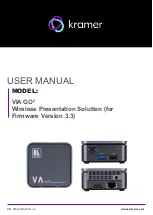
65
LFLim Hold (Low Frequency Limiter Hold Threshold)
During operation of the limiter, the algorithm is watching for very small decreases in aud
io level,
such as what occurs right after a sudden peak. When this occurs, the limiter release is temporarily
stopped. The result is a drastic reduction in intermodulation distortion and a more open sound,
even though the audio is still quite dense. The level at which the hold takes place is controlled by
the setting of the hold Thresh control. Higher numbers cause the hold to activate at higher audio
levels. The action of limiter hold also works in conjunction with the preceding AGC gates to
reduce noise rush up during periods of no audio or pauses in speech.
Lim Thresh (Limiter Threshold)
This control adjusts the threshold level of where limiting begins. Lower settings will increase the
amount of limiting and decrease the level going
to the following Bass Clipper (low band only) or
Final Limiter stage. Conversely, higher settings will raise the limit threshold, causing less limiting
but feeding more level into the following Bass Clipper (low band only) or Final Limiter stage.
Normally, we recommend leaving the Limiter Thresholds at the factory setting.
<-Exit
Click on this option to return to the
Adjust Processing
submenu
Mid Band Limiter
See description of settings for Low Band Limiter
Presence Band Limiter
See description of settings for Low Band Limiter
High Band Limiter
See description of settings for Low Band Limiter
Bass Clipper
The Bass Clipper operates between the output of the Low Band Limiter and the Low Band Mixer, the output of
which feeds the Final Limiter.
Its purpose is to keep excessive bass out of the Final Limiter, reducing IM
(intermodulation) distortion while keeping and even enhancing the bass punch of the program material. There are
two different Bass Clipper styles available (described below).
NOT
E: Defeating both of the bass clipper sections will not reduce delay throughput.
Clip Drv (Bass Clipper Drive)
Adjusts the drive level to the Bass Clipper over a range of +/-
6 dB. Higher settings will increase
the amount of Bass Clipping, increasing bass density while keeping the actual peak bass level fed
to the Mixer the same This allows you to reduce the Low Band Mixer control to reduce IM
distortion in the Final Limiter without reducing the amount of perceived bass in the program
material. Be careful!
Too much clipping by the Bass Clipper can soften bass 'punch'. It may also
be heard as a “rattling” sound in the bass or cause additional artifacts in the codec following the
Omnia ONE Studio Pro.
















































